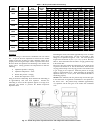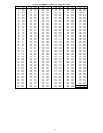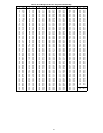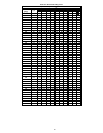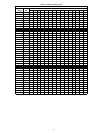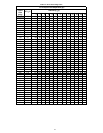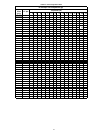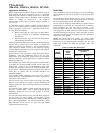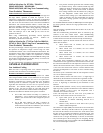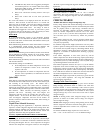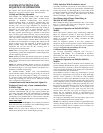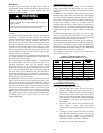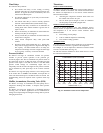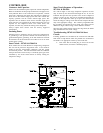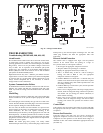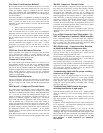
45
Airflow Selections for 187ANA / 286ANA /
180ANA024,36,48 / 180ANA060 /
288ANA024,36,48, 60 Using Non--Communicating
(Non--Evolution) Thermostats
Airflow Selection for 315AAV/355AAV Furnaces
The 315AAV/355AAV variable--speed furnaces provide high--and
low--stage blower operation to match the capacities of the
compressor at high and low stages. To select the recommended
airflow and for adjustments to the manual switches labeled SW1--5,
AC, and CF on the control board, refer to the furnace Installation
Instructions. The 315AAV/355AAV utilizes a control center that
allows the installing technician to select the proper airflows. The
HP switch determines the airflow during high--stage compressor
operation. Airflow for high-- and low--stage can be calculated at
either 350 CFM per ton or 400 CFM per ton, based on the
positions of SW1--5.
When using communicating (Evolution) control, dipswitch
adjustments are not necessary on furnaces. Airflows are
determined by Evolution Control setup.
Airflow Selection for FV4 Fan Coils for 180ANA,
187ANA, 286A, 288A Using Non--Communicating
(Non--Evolution) Thermostats
The FV4 provides high-- and low--stage blower operation to match
the capacities of compressor at high-- and low--stage. To select
recommended airflow, refer to FV4 Installation Instructions. The
FV4 utilizes an Easy Select control board that allows the installing
technician to select proper airflows. For adjustments to control
board, select appropriate HP SIZE and CFM ADJUST setting. This
fan coil has an adjustable blower off delay factory set at 90 sec for
high-- and low--stage blower operation.
For other combinations of equipment consult Product Data Digest.
GENERAL INFORMATION
Low Ambient Cooling
When this unit is operating below 55_F outdoor temperature,
provisions must be made for low ambient operation.
Evolution controlled low ambient
cooling:
This unit is capable of low ambient cooling without a kit ONLY
when using Evolution control. A low ambient kit is not required,
and the outdoor fan motor does not need to be replaced for
Evolution controlled low ambient operation. The Evolution
Control provides an automatic evaporator coil freeze protection
algorithm that eliminates the need for an evaporator freeze
thermostat. Low ambient cooling must be enabled in the User
Interface set up. Fan may not begin to cycle until about 40_F
OAT. Fan will cycle based on coil and outdoor air temperature.
Evolution controlled low ambient mode operates as follows:
S Fan is OFF when outdoor coil temp is < (outdoor air
temperature + 3_F) or outdoor fan has been ON for 30
minutes. (Fan is turned off to allow refrigerant system to
stabilize.)
S Fan is ON when outdoor coil temp > (outdoor air
temperature + 25_F) or outdoor coil temp > 80_Forif
outdoor fan has been OFF for 30 minutes. (Fan is turned
on to allow refrigerant system to stabilize.)
S Low pressure switch is ignored for first 3 minutes during
low ambient start up. After 3 minutes, if LPS trips, then
outdoor fan motor is turned off for 10 minutes, with the
compressor running. If LPS closes within 10 minutes
then cooling continues with the outdoor fan cycling per
the coil temperature routine listed above for the
remainder of the cooling cycle. If the LPS does not close
within 10 minutes, then the normal LPS trip response
(shut down cooling operation and generate LPS trip
error) will occur.
For 180ANA/288ANA models, the PWM output for both high and
low stage equals the value for low stage operation below 104_F.
Defrost
This control offers 5 possible defrost interval times: 30, 60, 90, 120
minutes, or AUTO.
With non--communicating thermostats, these are selected by dip
switches on the unit control board. With communicating
thermostats, the Evolution Control User Interface. The Evolution
Control selection overrides the control board dip switch settings.
AUTO defrost adjusts the defrost interval time based on the last
defrost time as follows:
S When defrost time <3 minutes, the next defrost
interval=120 minutes.
S When defrost time 3--5 minutes, the next defrost
interval=90 minutes.
S When defrost time 5--7 minutes, the next defrost
interval=60 minutes.
S When defrost time >7 minutes, the next defrost
interval=30 minutes.
The control board accumulates compressor run time. As the
accumulated run time approaches the selected defrost interval time,
the control board monitors the coil temperature sensor for a defrost
demand. If a defrost demand exists, a defrost cycle will be initiated
at the end of the selected time interval. A defrost demand exists
when the coil temperature is at or below 32_F for 4 minutes during
the interval.
The defrost cycle is terminated when the coil temperature reaches
65_F or 10 minutes has passed.
On 286A models, defrost will occur in low-- or high--stage as
demanded by the thermostat or User Interface regardless of OAT
On 288A models, when OAT is >25_F(--3.9_C), defrost will occur
in low-- or high--stage as demanded by the thermostat or User
Interface.
On 288A models, if OAT is ≤25_F(--3.9_C), defrost will occur in
high--stage only, regardless of thermostat or User Interface demand,
and will terminate at 50_F(10_C) coil temperature with a
minimum of 2.5 minutes in defrost.
If the coil temperature does not reach 32_F(0_C) within the
interval, the interval timer will be reset and start over.
S Upon initial power up the first defrost interval is
defaulted to 30 minutes. Remaining intervals are at
selected times.
S Defrost is only allowed to occur below 50_F(10_C)
outdoor ambient temperature.
The outdoor fan output (ODF) will remain off for 20 seconds after
termination. This delay will allow time for the system to capture
the heat from the outdoor coil and reduce the “steam cloud” effect
that may occur on transition from defrost to the heating cycle. The
outdoor fan output OFF delay of 20 seconds may be defeated to
enable the fan to energize immediately at the time of termination
and 12 seconds prior to the reversing valve de--energizing, through
the User Interface setup screen available with SYSTXBBUID01--C
UI, or forced defrost pins as follows:



